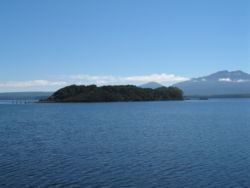Status Abandoned Managed by British Government Opened 1822 | Closed 1833 Security class Penal Colony | |
 | ||
Governor Lt-Governor William Sorell (1822-24)Lt-governor George Arthur (1824-33) | ||
Tours tv com macquarie harbour penal station
The Macquarie Harbour Penal Station, a former British colonial penal settlement, established on Sarah Island, Macquarie Harbour, in the former colony of Van Diemen's Land, now Tasmania, operated between 1822 and 1833. The settlement housed mainly male convicts, with a small number of women. During its 11 years of operation, the penal colony achieved a reputation as one of the harshest penal settlements in the Australian colonies.
Contents
- Tours tv com macquarie harbour penal station
- Map of Sarah Island Southwest TAS 7139 Australia
- For the term of his natural life the real story macquarie harbour penal station tasmania
- Rationale for establishment
- Conditions
- Later use and current conditions
- In the media
- Known escapees
- References
Map of Sarah Island, Southwest TAS 7139, Australia
For the term of his natural life the real story macquarie harbour penal station tasmania
Rationale for establishment
The penal station was established as a place of banishment within the Australian colonies. It took the worst convicts and those who had escaped from other settlements. The isolated land was ideally suited for its purpose. It was separated from the mainland by treacherous seas, surrounded by a mountainous wilderness and was hundreds of miles away from the colony's other settled areas. The only seaward access was through a treacherous narrow channel known as Hells Gates.
Strong tidal currents resulted in the deaths of many convicts before they even reached the settlement due to ships foundering in the narrow rocky channel. The surveyor who mapped Sarah Island concluded that the chances of escape were "next to impossible". Neighbouring Grummet Island, a small island to the North west, was used for solitary confinement.
Despite its isolated location, a considerable number of convicts attempted to escape from the island. Bushranger Matthew Brady was among a party that successfully escaped to Hobart in 1824 after tying up their overseer and seizing a boat. James Goodwin was pardoned after his 1828 escape and was subsequently employed to make official surveys of the wilderness he had passed through. Sarah Island's most infamous escapee was Alexander Pearce who managed to get away twice. On both occasions, he cannibalized his fellow escapees.
Lieutenant-Governor William Sorell wanted the new penal colony to be economically viable. It could then reimburse the British government for the expense of its establishment. Convicts were employed in the shipbuilding industry. For a short period, it was the largest shipbuilding operation in the Australian colonies. Chained convicts had the task of cutting down Huon pine trees and rafting the logs down the river. Eventually the heavily forested island was cleared by the convicts. A tall wall was then built along the windward side of the island to provide shelter for the shipyards from the roaring forties blowing up the harbour.
Conditions
As Sarah Island could not produce food, malnutrition, dysentery, and scurvy were often rampant among the convict population. The penal colony had to be supplied by sea. Living conditions were particularly bad in the early years of the settlement. The settlement was so crowded, convicts were unable to sleep on their backs in the communal barracks. Punishment involved solitary confinement and regular floggings - 9,100 lashes were given in 1823.
In 1824 a prisoner named Trenham killed another convict in order to be executed rather than face further imprisonment at Macquarie Harbour Penal Station.
It was finally closed in late 1833. Most of the remaining convicts were then relocated to Port Arthur. Ten convicts remained behind in January 1834 finishing the construction of a brig; however, they seized the opportunity to escape with it in the Frederick escape.
Later use and current conditions
The island was later used for pining purposes, and was known by the piners as Settlement Island, rather than Sarah Island, though it has since reverted to its original name.
The ruins of the settlement remain today as the Sarah Island Historic Site —part of the larger Tasmanian Wilderness World Heritage Area—though they are not as well preserved as those at better-known Port Arthur. The island is accessible via ferries and charter boats operating out of the town of Strahan.
In the media
Sarah Island has been frequently featured in Australian literature and theatre, often representing the worst excesses of the British convict system.
Notable books include:
In Strahan, the main port and town on the shores of Macquarie Harbour today Australia's longest running play The Ship that Never Was by Tasmanian author Richard Davey dramatises the Frederick escape, the last escape from the island. His book The Sarah Island Conspiracies - Being an account of twelve voyages to Macquarie Harbour and Sarah Island furthers understanding of the history and the recent archaeological work on the island.
The films The Last Confession of Alexander Pearce and Van Diemen's Land deal with one of the more notorious escapees.
